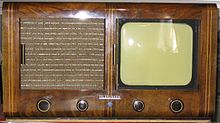Rectangular picture tube
A rectangular picture tube has in contrast to the round bottom picture tube a substantially rectangular screen, not just a rectangular screen clipping. The manufacture of a rectangular picture tube requires considerably more technical glass skills than the manufacture of a round-bottom picture tube with a curved, circular screen.
The glass bulb of the first RFB / T2 rectangular picture tube from the German standard television receiver E 1 from 1939 was reinforced with leukoplast for stabilization . Walter Haas names the Telefunken engineer Bartels, who later went to the USA, as the developer of this tube.
After the Second World War , the first rectangular picture tubes came on the market again from around 1951 (MW 36-22) and - with very few exceptions - were built into German black-and-white televisions, while in the USA, Great Britain and the Eastern Bloc up to the middle or At the end of the 1950s the cheaper and easier to manufacture round-bottom picture tubes were used.
For color television , there were rectangular picture tubes with a curved screen from the mid-1960s. The really flat rectangular color picture tubes did not come onto the market until the 1990s, the curvature was relocated to the inside of the piston, while the outside was made flat. Since the turn of the millennium, flat screens have become increasingly popular, displacing the picture tubes.
Footnotes
- ^ Walter Haas (1967): color television. A gift of our century. Düsseldorf and Vienna: Econ, p. 150
